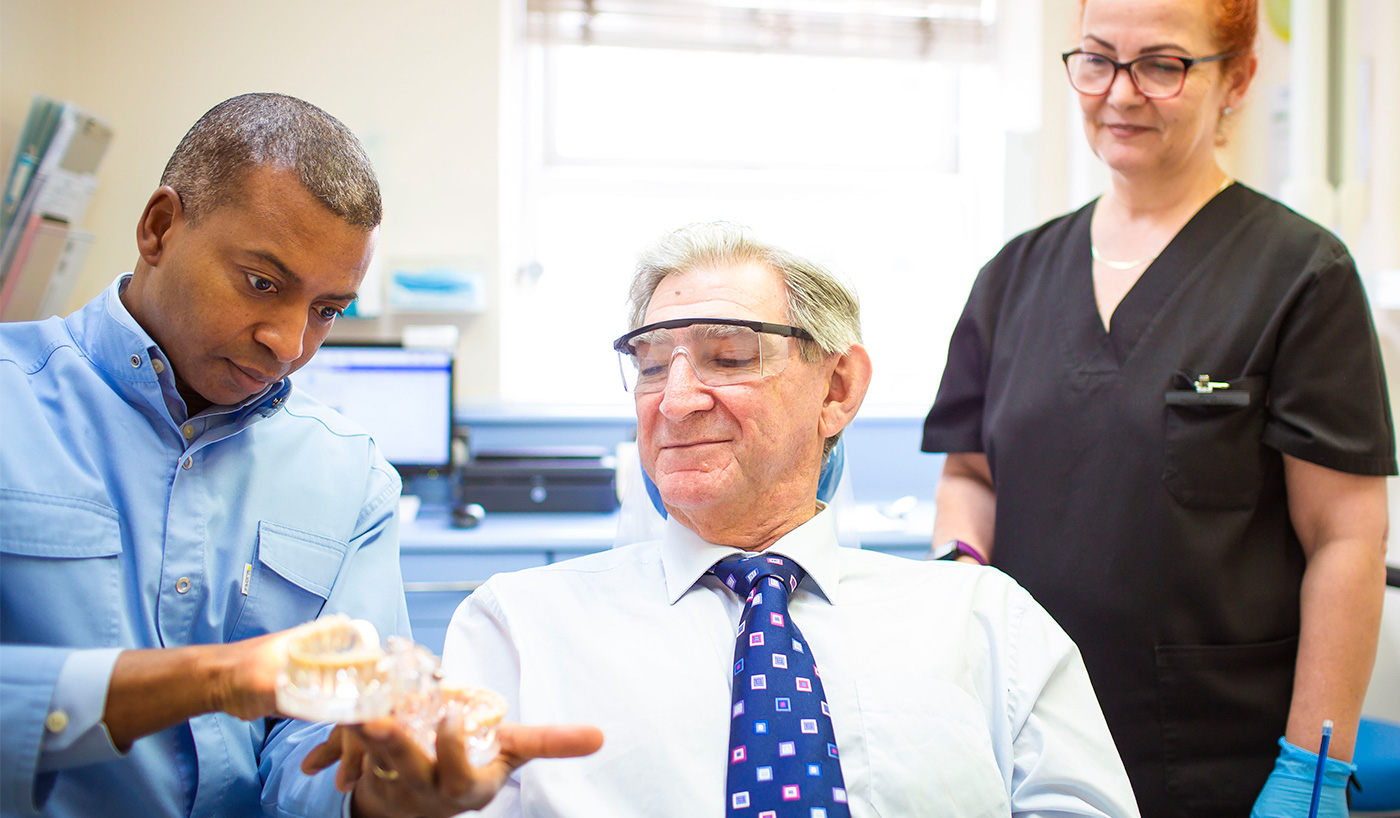Overdentures are a type of denture fitted over or attached to either root-filled tooth roots or dental implants. This technique gives the denture greater stability, support and retention. Overdentures are a more stable alternative to traditional denture fixtures.
Before fitting overdentures the dental practitioner will need to establish tooth root condition and suitability for treatment. Tooth roots need to be healthy and free from infection. Patients who have had successful root canal treatment may be good candidates for overdentures.

Questions? We've got the answers!
Once oral condition is evaluated and the need for overdenture treatment is identified, one of two models of dental implant-retained overdentures may be recommended. These include either bar-retained or ball-retained implant-supported overdentures. Usually attached by two dental implants inserted into the jaw bone structure, the ball- or bar-retained overdentures are fully supported for optimal retention and stability.
Implant-retained overdentures are usually fitted within the anterior location of the mouth, where fewer nerves are present but more jaw bone is prominent. This anterior oral region offers greater suitability for dental implants, particularly for patients with tooth loss over a long time scale.
Ball-retained overdentures have the capacity to attach to five dental implants in total. These retained implant-supported overdentures are made of gum-like acrylic or porcelain. With bar-retained overdentures, a thin metal bar follows the contours of the jaw bone and the dentures are accurately attached to this bar with clips.
The need for multiple dental implants involves more intensive oral surgery and increased costs. Time and money is saved with overdentures because fewer implants are needed to fit them. Patients can have overdentures without the need for bone and gum grafting operations.
Root supported overdentures preserve the existing tooth root structure surrounding the jaw bone and protect the bone from shrinkage. Patients retain the sense of oral proprioception and do not experience bone shrinkage. Overdentures sustain the jaw bone structure for future dental implant treatment if necessary.
Both root-filled tooth roots and dental implant-supported overdentures give enhanced oral stability. Overdentures provide greater retention than traditional full denture fixtures because of the structures they are fixed to. Patients need not feel concerned about dentures slipping or sliding in the mouth, since overdentures are securely attached to either the root-filled tooth root or dental implant supports.
Individuals with overdentures experience increased confidence in oral function and self-image. Speaking and eating is as comfortable as with normal teeth. Overdentures do not require adhesive, their stability improves facial form and they provide natural looking smiles.
The duration of treatment for overdentures depends on the oral health of the patient, such as if tooth root infection is present and needs treating first. The time the procedure takes differs on a case-by-case basis. To give an idea of treatment time, overdentures with dental implants may range from between 3 to 6 months.
During an initial consultation patient health is evaluated to ensure suitability for overdentures. This will also incorporate a discussion of patients’ medical and dental history. If overdenture treatment is recommended as an appropriate choice, the risks and benefits will then be discussed prior to obtaining consent for treatment.
If patients wish to proceed with treatment further diagnostic testing is done, such as X-ray imaging and oral impressions. In order to establish if the jaw bone is strong and wide enough for dental implants, a cone beam CT scan will be carried out. The scan allows the dentist to identify sinus and nerve location, to ensure that dental implants will not damage this region.
Temporary dentures are custom-made for the patient to wear before implantation surgery. An initial surgery prepares the gum for dental implants; an opening is created in the gum tissue and a hole gently made in the jaw bone, so that the dental implants may be inserted. Placing no pressure on these new implants is vital for timely healing and to reduce discomfort.
A healing period follows where the dental implants fuse with the jaw bone (a process called osseointegration). A second surgery is then performed to re-open gum tissue at the implant location, so that the peaks of the implants may be fitted with a healing collar. This procedure allows the gum to heal properly before the overdentures are attached and fixed in position.
The entire overdenture treatment process takes between 3 to 6 months, with patients soon able to enjoy secure, natural looking smiles.
A hygienic benefit of overdentures is that they are removable and may be taken out at night for cleaning. Doing so ensures the healthy condition of overdentures in the long run. As with regular oral hygiene maintenance, dental implants require regular cleaning to prevent infection. Having frequent dental checks is necessary. The dentist is able to monitor the condition of the overdentures and make adjustments or provide treatment where necessary.
